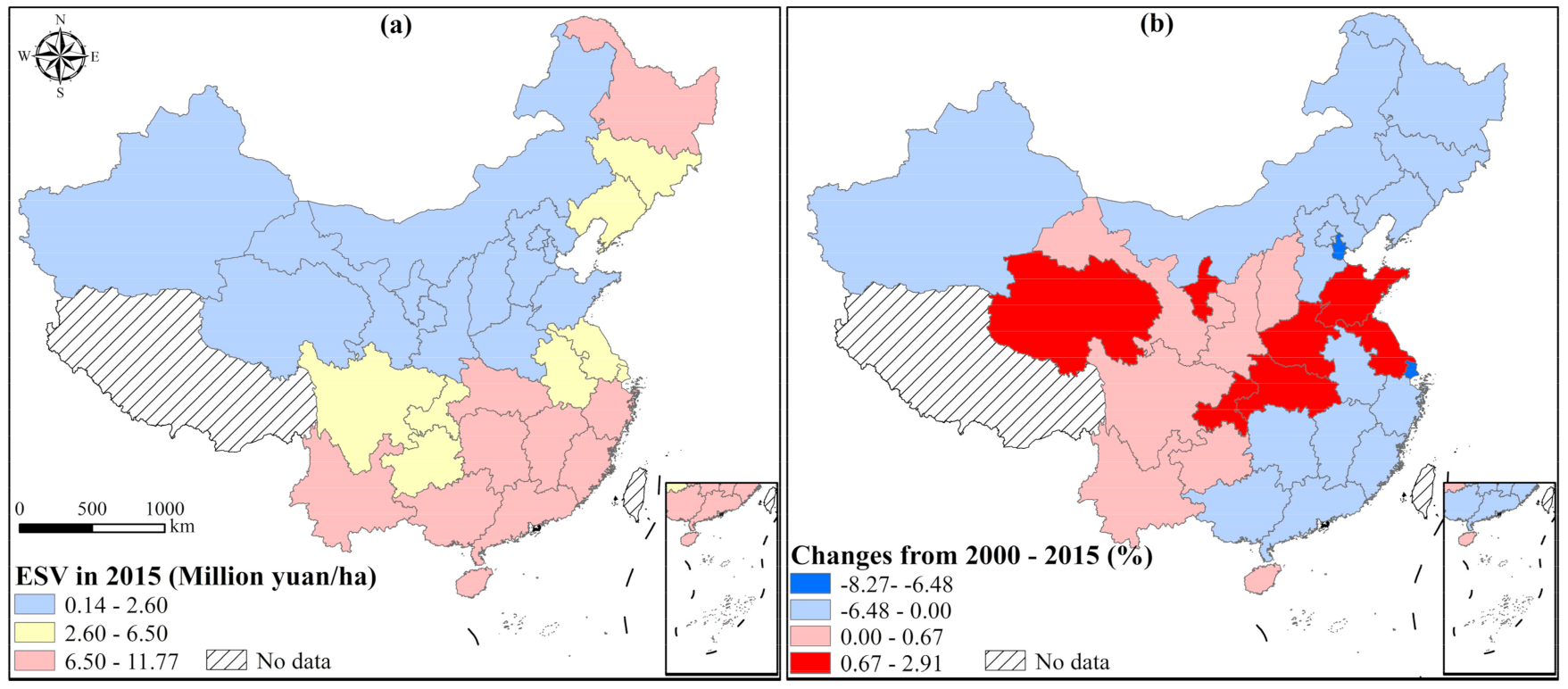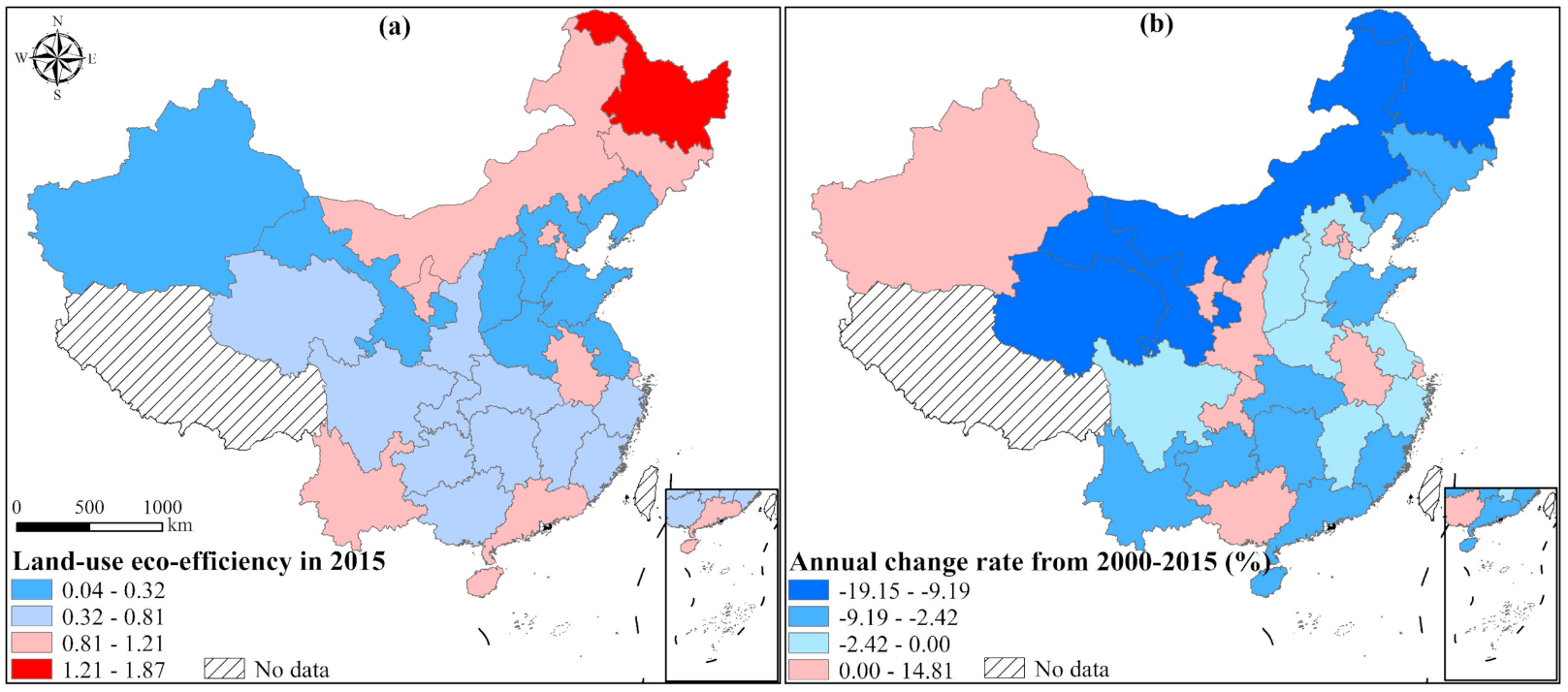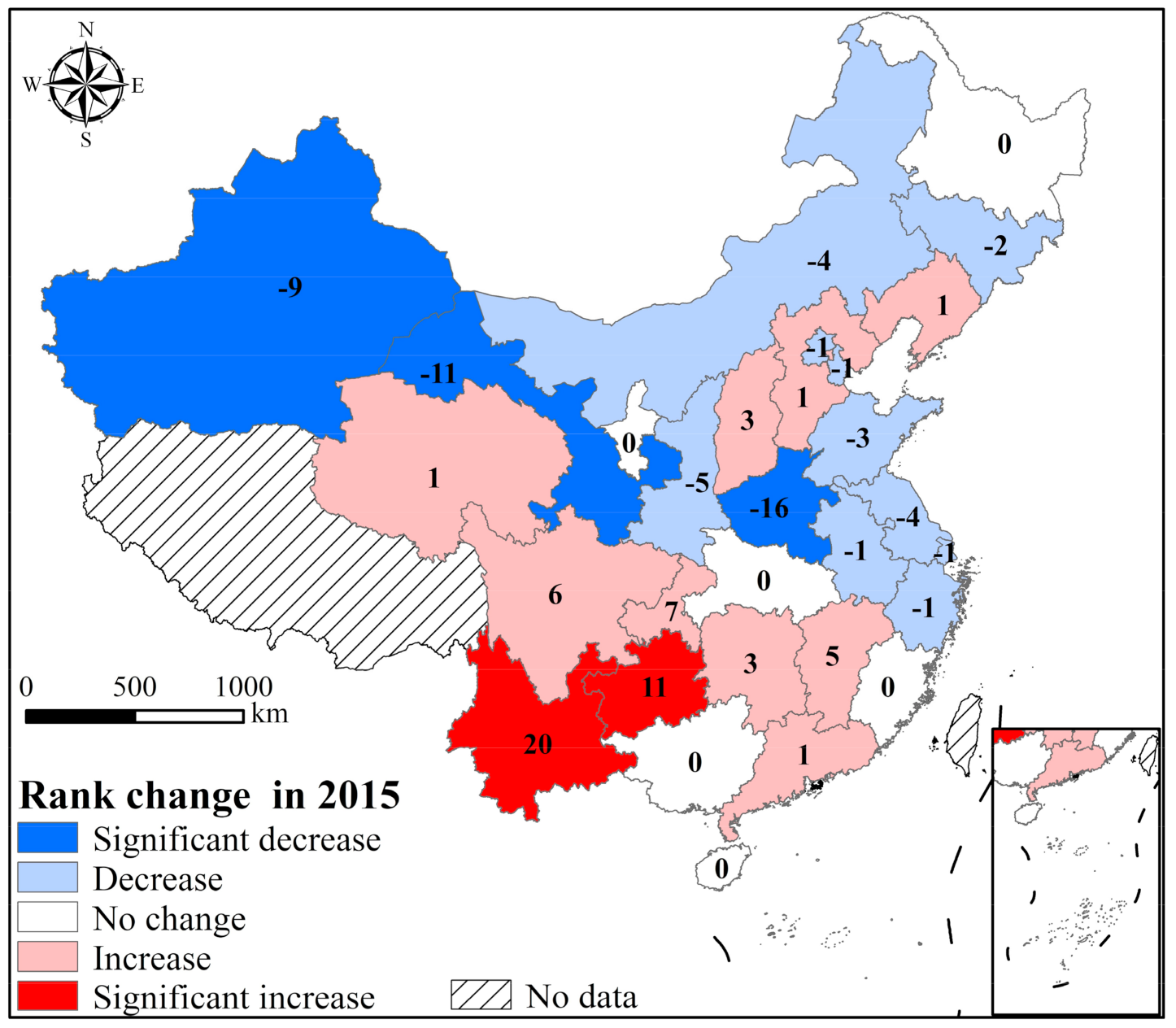1. Introduction
Ecosystem services (ES) are goods and services that are directly or indirectly related to human well-being and sustainability, and the supply of ecosystem services is subject to specific land-use structures and patterns [
1]. However, emerging evidence shows that land-use changes can make fundamental impacts on ecosystem services provisioning [
2]. It has been estimated that the global loss of ES value (ESV) can reach 4.3–20.2 trillion USD/year due to the land-use change [
3]. A significant decline in global loss of ES value is also reported in China, which is 4.18–91.09 billion USD from 1988 to 2008 [
4]. Moreover, in a small region of Nigeria, land-use changes led to a 4.83% decline in total ESV during 2000–2010 [
5]. Facing this increasingly worsening situation, it has great significance to enhance the sustainable development through considering the ESV losses.
In principle, expansion of built-up land would change local land-use structures and patterns, thus directly affecting the supply of ES. For example, the heavy use of cultivated land will exert direct impacts on food production [
6,
7]. On the other hand, the land-use changes can strongly affect local climatic conditions [
8], resulting in indirect responses of ESV to land-use changes, such as biodiversity loss [
9]. Therefore, the trade-off between economic benefits and ESV losses needs to be addressed in the process of rapid urbanization. The dissection of the trade-off can provide important clues for sustainable development [
10,
11]. Currently, scholars have conducted a lot of meaningful work to ease this trade-off. For example, payments for ecosystem services (PES) is recommended as an efficient economic tool that can internalize the ecological cost into specific policy making [
12]. In addition, economists are trying to construct a framework of the System of Environmental and Economic Accounting (SEEA), which can provide valuable information for sustainable policy-making [
13].
In the process of urbanization in China, there are many issues associated with land-use, such as disordered exploitation, leave unused, low land-use efficiency, and so on [
14,
15]. Intensive land-use has been considered as an effective way to improve land-use efficiency. In general, high land-use efficiency means more economic benefits with less inputs per unit area [
16]. The economic output per unit area has been used to represent land-use efficiency [
17]. More generally, the non-parametric model, slacks-based model (SBM), is frequently applied to evaluate land-use efficiency [
18,
19,
20]. In SBM, the scientific construction of an input–output index system is the premise of evaluating efficiency reasonably. The increasing environmental problems have led to extensive studies on evaluating the eco-efficiency of land-use in recent years [
10,
15,
21,
22]. Some undesirable outputs are considered in the efficiency evaluation, such as exhaust gas, waste water discharge, and solid waste discharge [
10,
15,
21,
22]. There is evidence that economic efficiency was higher than eco-efficiency when the undesirable outputs were taken into account. For example, after considering multiple undesirable outputs, including COD discharge, NO
x, SO
2, soot emission, dust emission, and industrial solid wastes, Zhang et al. [
23] found that China’s average eco-efficiency was reduced to 0.39 from 0.50. Huang et al. [
24] compared the results with and without undesirable outputs. They found that the average of eco-efficiency in China was reduced by 0.13 after considering COD, wastewater, exhaust gas, SO
2, dust, solid waste, and smoke dust. These evidences highlight the importance of these undesirable outputs in the evaluation of eco-efficiency. However, the land-use change, especially in the context of rapid urbanization, exerts substantial impacts on provision of ES [
2,
3,
4,
5,
25,
26,
27], seriously threatening the sustainable development. Therefore, it is necessary to incorporate the ESV impact into the evaluation of land-use eco-efficiency, otherwise, it may lead to unreliable conclusions [
28].
Currently, Shi et al. [
29] proposed a new eco-efficiency by dividing the economic output per unit area by the ESV per unit area. The use of this indicator has been reported to analyze the eco-efficiency changes from 2007 to 2015 in the case of Ningguo Gangkou industrial park in eastern China. However, this indicator cannot eliminate the influence of random factors, thus a comprehensive eco-efficiency indicator reflecting endogenous impacts should be provided. In addition, the eco-efficiency of provinces in China was evaluated in 2014 by a super-efficiency slacks-based model (Super-SBM), and the eco-efficiency in the most southeastern provinces was found to decline by taking into account the provincial aggregate ESV [
28]. However, the variations of ESV are mainly driven by land-use changes, thus, considering the aggregated ESV in eco-efficiency calculation is unreasonable and unpersuasive in theory. In sum, current attempts to integrate the ESV into eco-efficiency still have some drawbacks. We attempt to make some improvements from the following three aspects: First, this study measures the eco-efficiency from the perspective of land-use change. Second, the spatial–temporal changes of the eco-efficiency are explored. Finally, we further analyze the driving factors of the eco-efficiency, which can provide more specific policy implications.
Finally, since the 1990s, China has undergone a remarkable urbanization and industrialization, and one of the most prominent features in this process is the dramatic expansion of built-up land [
30]. As a valuable input factor, land resources are the basis of economic development, providing essential room for human activities and industrial organizations [
31]. However, an extensive expansion of built-up land has also made substantial impacts on land-use patterns, such that a substantial amount of forest and cultivated land are encroached on during the rapid urbanization [
25,
26]. This deeply affects land ecosystems, thus hampering the continuous supply of ecosystem services [
2]. Facing the increasing contradiction between economic expansion and land ecological conservation, it has great practical significance to evaluate and explore regional land-use eco-efficiency and its driving factors [
15,
32]. The main contents are organized as follows: We first introduced the data and the methods employed in this study. Then, the results were presented and analyzed, including the spatial–temporal variations of ESV and land-use eco-efficiency in China during 2000 to 2015, and the driving factors. The discussion, policy implication, and conclusion are given at the final part.
4. Discussion and Policy Implication
Due to the rapid urbanization, the loss and degradation of ES has become an urgent problem. However, there is still a lack of effective methods to guide sustainable development. This study proposed a land use-based input–output index system, which incorporated the important ecological factor of ESV, and further, by employing the Super-SBM and STIRPAT model, we calculated and explored the spatial–temporal changes and driving factors of this creative eco-efficiency.
In the present study, we evaluated the ESV in China from 2000 to 2015. We found that the evaluated ESV was 28.09 trillion yuan (at the price of 2000) in 2015. One important finding in the present study is that only the western region exhibited a steady growth during the 15 years, while the eastern, central, and northeastern regions showed dramatic declines after 2005 according to the spatial–temporal changes in ESV. On the one hand, our results demonstrated that the major ecological protection projects were highly effective in the western region, e.g., the Grain for Green Project. On the other hand, rapid urban expansion in the mid-eastern region has encroached on a great deal of natural or semi-natural land, resulting in significant declines of the ESV in these areas. Therefore, in the future, more ecological conservation projects should be initiated and strengthened in the western region [
52], and further extended to the mid-east. Moreover, strict restrictions on protection of cultivated land and urban development should be implemented, especially in central eastern areas.
The land-use eco-efficiency in China’s provinces during 2000–2015 was calculated based on the built land use-based input–output index system. A downward trend in eco-efficiency was identified. This result differed from most previous studies in which an upward trend in eco-efficiency in recent years has been reported [
24]. We demonstrated that the ESV has considerable impacts on the evaluation of land-use eco-efficiency (
Table 5 or
Figure 2). Land-use change is one of the most prominent features of urbanization, which directly or indirectly affects the supply of ecological service. Therefore, the consideration of the ESV is highly essential when evaluating regional land-use eco-efficiency. In addition, an interesting finding is that some provinces with declining ESV showed eco-efficiency improvement. Beijing, Tianjin, and Shanghai were typical examples (cf.
Figure 1b and
Figure 2b). Due to the remarkable economic growth in these provinces, the contribution of economic growth outweighs the ESV losses, thus leading to an upward trend in eco-efficiency. However, it is worth noting that these provinces may be over-consuming local natural resources, hence, the total scale of built-up land should be strictly controlled, and more green infrastructures and ecological lands should be provided during urban development.
Finally, we further explored the driving factors of land-use eco-efficiency using the STIRPAT model. Our results indicate a “U” shaped relationship between land-use eco-efficiency and land urbanization in China. The improvement of the eco-efficiency may result from the intensive land-use and/or an increase in green infrastructure, as well as the extensive economic growth. Therefore, the underlying causes of this relationship need to be explored in the future. For policy makers, optimizing the spatial structure, promoting orderly development, and investing in green infrastructure are very important for sustainable urban development. In addition, the government should continue to strengthen its investment in the technology, especially in the field of green-oriented technological innovation [
55].
5. Conclusions
This study evaluated the land-use eco-efficiency of China’s provinces from 2000 to 2015. By incorporating the ESV into the input-output index system, we explored spatial-temporal changes of the comprehensive land-use eco-efficiency, which could better reflect regional sustainability level. A Super-SBM model was applied to measure the efficiency, and then a panel STIRPAT model was employed to explore the driving factors of the efficiency. The results showed that the overall ESV experienced an inverted U-shaped trend during 2000–2015, but with obvious regional differences. In the eastern and central regions, they had a similar inverted U-shaped trend, while the western and northeastern regions presented a steady upward and downward trend, respectively. In addition, after incorporating regional ESV, the evaluated land-use eco-efficiency declined from 0.87 in 2000 to 0.68 in 2015. For spatial distribution, the eco-efficiency of the northeastern region was the highest, followed by the eastern region, the western region, and the central region. Finally, the results of the STIRPAT model indicated a U-shaped relationship between land-use eco-efficiency and land urbanization, and a significant improvement of the eco-efficiency by the technological innovation. These findings indicate that ecosystem services are important determinants for regional sustainable development. Therefore, land development should pay additional attention to the land ecosystems, especially the closely related provisions of ecosystem services.







